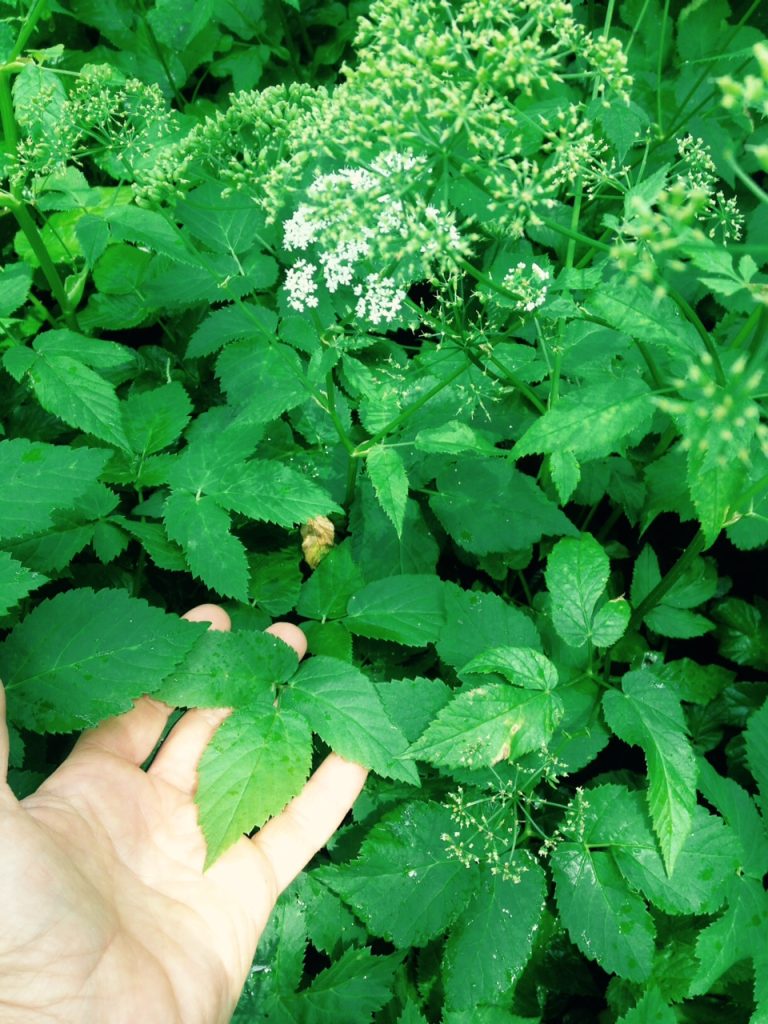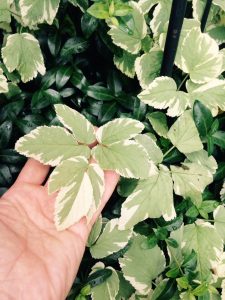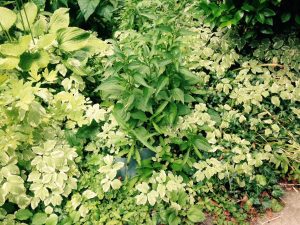
Aegopodium (ee-guh-POH-dee-um) podagraria (pod-uh-GRAR-ee-uh),
Bishop’s Weed, also called Goutweed, Goutwort, Ground Elder, Herb Gerard, English Masterwort, Wild Masterwort, Pigweed and Snow-in-the-Mountain, is an herbaceous perennial ground cover that grows 1 ½ to 2 feet in height and spreads through seed dispersion and rhizomes. It is part of the carrot family (Aplaceae) and grows in shady places. Native to Eurasia, it is commonly introduced as an ornamental plant and can pose an ecological threat as an invasive species.
Here is the plant description from Minnasotawildflowers.info:
“Leaves are compound; basal and lower stem leaves are long stalked and twice compound with up to 9 leaflets. Leaflets are 1 to 3 inches long, generally egg-shaped with pointed tips, toothed, mostly hairless, and often deeply cleft and asymmetrical at the base. “Wild” forms have solid green leaves. Cultivated forms have variegated leaves, green to gray with white edging. The stems are branched, ridged, and hairless. Fruit is oval, about 1/6 inch long, slightly compressed, and ribbed. As fruit develops, the styles bend at the base and spread away from each other, but eventually fall off. When mature, the fruit splits into 2 seeds.”
The most common type has fully green foliage and offers umbels of delicate white flowers in mid June. These flowers are also attractive to bees, butterflies and birds. Less common and slightly less invasive is the variegated variety (Aegopodium podagraria variegatum). The name Bishops’ Weed may come from its propensity to grow near ecclesiastical ruins.

Relentless!
Some say it’s reliable while others curse it as relentless. Either way, Bishop’s Weed is one of the hardiest plants around, with the ability to withstand temperatures of minus 5 degrees. It is a prolific spreader and can cover large areas within one season. Seed dispersion is limited by shading and undisturbed soil. The plant’s invasive habit comes mostly from aggressive underground rhizome growth. Bishop’s weed can greatly limit ground cover polycultures and the establishment of tree and shrub seedlings. Beyond this, the plant is dispersed widely within our region and beyond with its introduction by humans who plant it as an ornamental ground cover and by accidentally spreading roots and rhizomes in garden waste.
Once established, bishop’s weed is very difficult to control. The most effective and environmentally friendly method is to smother the entire bed in early spring or over the course of a season with cardboard or weed cover. Plant foliage will die but the rhizomes will continue to sprout new plants if not removed in their entirety.
If You Can’t Beat ‘Em, Eat ‘Em.*
Having trouble removing this aggressive trifoliate? If correctly identified, you might try munching those three leaves instead. As a medicinal and edible plant, the tender leaves of Bishop’s Weed were eaten during the Middle Ages, much as we use leafy greens like spinach and Swiss chard today. The leaves are best harvested before the plant flowers in early summer and the leaves can remain tasty through the season if the flowers are pinched off as they grow. Cutting off the flowers will also reduce the plant’s spreading. The taste of the leaves is mild and sweet, with a hint of carrot and cilantro. The texture is that of mint. I have a healthy stand in my backyard and plan on adding it to my salads.

As I mentioned above, Bishop’s Weed is also known as Goutweed, and was reputed to be a treatment for arthritis and gout. The Latin name (Aegopodium podagraria), suggests these historical uses. Aegopodium comes from Greek’s aix and aigos, meaning “goat” and podos which translates to “foot”. The Latin word for gout is podagra, which lends itself to gout weed’s species name. It was also known as “Goat Weed” due its trifoliate leaf structure resembling a goat’s foot.
Nicholas Culpeper (18 October 1616 – 10 January 1654), an English botanist, herbalist, physician, and astrologer, wrote of Goutweed as follows: “It is not to be supposed that Goutwort hath its name for nothing. Upon experiment it is found to heal the gout and sciatica. It is also used for aching joints and other cold pains.” As this description suggests, Goutweed, was known to cure aches and pains and therefor is likely an anti-inflammatory. Some credit consumption of the plant, others external use in the area of the gout, such as crushing the root, making a poultice, and holding it at the joint. The roots and leaves together can be steamed and placed on the hip to relieve sciatica. It has been used to also treat rheumatism, arthritis, psoriasis and bladder disorders.
From Web MD:
“Bishop’s weed is a plant. The seeds are used to make medicine.
The prescription drug methoxsalen (Oxsoralen, Methoxypsoralen) was originally prepared from bishop’s weed, but it is now made in the laboratory. Methoxsalen is used to treat psoriasis, a skin condition.
Bishop’s weed is used for digestive disorders, asthma, chest pain (angina), kidney stones, and fluid retention.
Some people apply bishop’s weed directly to the skin for skin conditions including psoriasis and vitiligo.”
Due to it’s aggressive growing habit and invasive classification, if you must plant Bishop’s Weed consider isolating it in containers, either away from the rest of your garden or by installing deep garden bed edging material to eliminate rhizome spreading.
* TTM does not offer medical advice and strongly suggests that you correctly identify any plant before ingesting it.

I would be very sure of my id on this. Not all members of the carrot family are friendly.
Wow! Who knew? I can use this as a medicine or garden salad addition. thanks for this, Donna.
Unless you are starving I wouldn’t add Bishops weed to your salad.. And subtract it from your garden by never allowing it to bloom and relentlessly
Digging it out. You may not be prone to using pesticides but your neighbor who inherits your goutweed by way of the wind or bird may use pesticides.
Bjk